
The theme for this year’s World Food Day was “Family Farming: Feeding the world, caring for the earth.”
The Food and Agriculture Organization (FAO) chose the theme to empower small holder farmers across the globe, highlighting the role of family farms in providing both food security and livelihood.
2014 is also the “International Year of Family Farming,” as declared by the UN General Assembly.
Globally, there are over 500 million family farms which are responsible for more than half of all agricultural production. Families, given the proper support, can help protect the environment and achieve sustainable development, FAO stressed.
How are agriculture, household food security, and hunger connected? Take a look at what the world's hunger statistics tell us:

The Philippines is known for its abundant natural resources, yet ironically, Filipino farmers are also among the country’s poorest basic sectors.
Since 2006, farmers have ranked second to fisherfolk in terms of high poverty incidence. As of 2012, the poverty incidence among farmers remain high at 38.3%, according to the National Statistical Coordination Board.
Since work conditions are not as desirable as other fields, less Filipinos are doing agricultural work. The share of agriculture in the country’s total employment has decreased over the years; in 2013, it was 31%.
Meanwhile, the share of agriculture in the national economy shows the same trend. In 2013, agriculture’s share in the Gross Domestic Product was only 10%, one point lower than the previous year.
Despite the many problems experienced by farmers and fisherfolk, many Filipinos still feel indifferent toward these issues. Why? Many do not feel the urgency to act since they are not involved in agricultural work.
But who did all the work to get food on plates? The ones on the front-lines who feed the world.
More about: #World-Food-day
















































